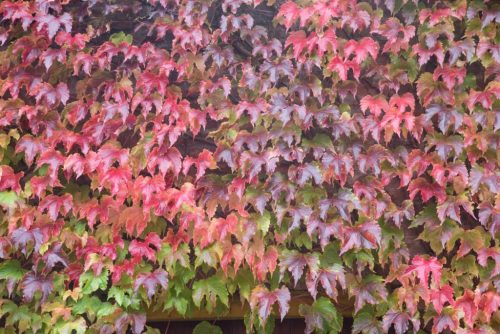Virginia creeper, woody climbing plant, belonging to the gra
Similar:
Virginia creeper (Parthenocissus quinquefolia)
Chinese Virginia creeper (Parthenocissus henryana)
Small-leaved Virginia creeper (Parthenocissus tricuspidata ‘Veitchii’)
Boston ivy (Parthenocissus tricuspidata)
You are viewing the mobile-adapted version of the page.
The one for tablets, laptop and desktop also provides general information, such as origin, toxicity and cultivation.
- The black berries (autumn) are poisonous; not for birds, they love them. Skin contact with the leaf may cause irritation
Virginia creeper – (Parthenocissus), woody climbing plant, belonging to the gra
The Virginia creeper likes not too heavy, nutrient-rich, moist soil, with normal acidity pH between 6 and 8). Preferably in sun or partial shade. Young shoots are susceptible to night frost in spring.
Virginia creeper can grow into a substantial climbing plant up to fifteen meter tall.
In autumn, the leaves turn deep red.
Virginia creeper is hardy, deciduous and self-adhesive on walls and fences. These should not face due south in the sun, then the surface is too “hot” for the suction cups by which the climber attaches. North-facing walls are also less suitable because no sun. Offshoots of the climber can still want to wriggle under roof tiles or gutters. In winter, when the leaves have fallen, prune the shoots to a meter below the gutter or eaves; this prevents problems. Winter is the best time to prune the Virginia creeper. Virginia creeper does not damage walls, even if the grouting is bad. Ivy can disrupt walls (grows in joints), the Virginia creeper does not. Virginia creeper keeps wall and fence dry in summer and early fall. Prevent the Virginia creeper from spreading over paintwork: the suction cups are difficult to remove.
Virginia creeper is a strong plant and not very susceptible to disease.
Fungi & diseases
Brown spots with gray fungus: gray mold (Botrytis
Dark brown spots develop on the leaf: bacterial canker (Pseudomonas syringae)
Other
During flowering, the Virginia creeper is much visited by insects, bees, flies and wasps. Sometimes the climber gets so crowded that it looks like a wasp’s nest is hiding inside. As a rule, this is not so: after flowering, the insects and also the wasps are gone.

